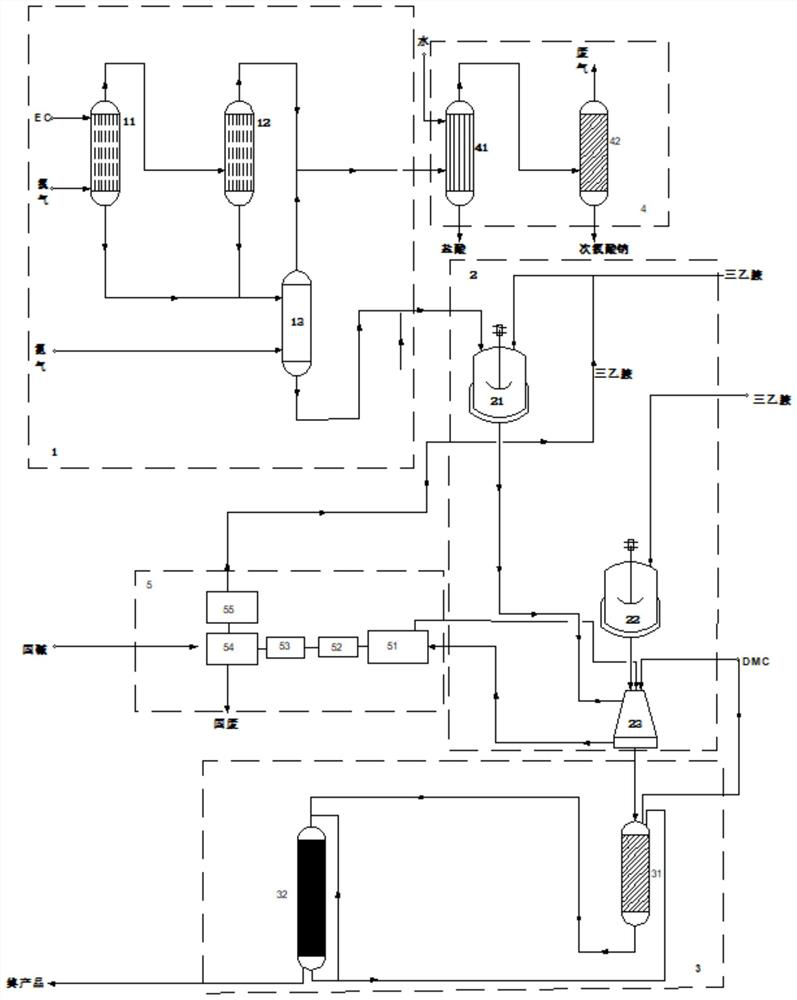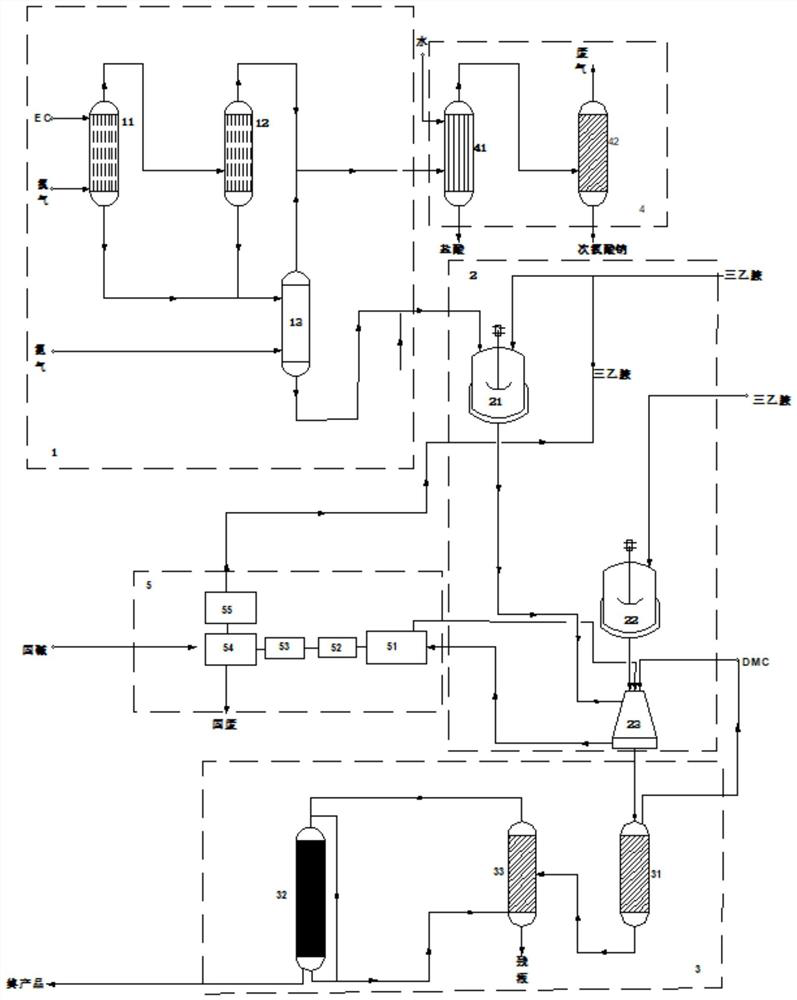High-purity vinylene carbonate as well as production method and application thereof
A vinylene carbonate and ethylene carbonate technology, applied in the field of high-purity vinylene carbonate, can solve the problems of insufficiency, poor economy, and increased energy consumption, and achieve the effects of eliminating residues, reducing energy consumption, and saving time
- Summary
- Abstract
- Description
- Claims
- Application Information
AI Technical Summary
Problems solved by technology
Method used
Image
Examples
Embodiment 1
[0039] using as figure 1 The production system shown produces vinylene carbonate and includes a primary reaction unit 1 , a secondary reaction unit 2 , a purification unit 3 , a by-product recovery unit 4 and a triethylamine recovery unit 5 .
[0040] The primary reaction unit 1 includes a first photolysis reaction tower 11, a second photolysis reaction tower 12 and a deacidification tower 13. The first photolysis reaction tower 11 and the second photolysis reaction tower 12 are used as containers for the chlorination reaction. An ultraviolet light assembly (not shown) and a temperature adjustment assembly (not shown) are arranged inside. The ultraviolet light assembly is used to provide ultraviolet light conditions for the chlorination reaction, and the temperature adjustment assembly is used to control the temperature of the chlorination reaction. The photolysis reaction tower is in the prior art and will not be repeated here.
[0041] The first photolysis reaction tower 11...
Embodiment 2
[0079] like figure 2 The production system shown, the difference between this example and Example 1 is: the temperature of the precipitation treatment is 40 ° C, the pressure is 9 kPa; the communication pipeline between the precipitation tower 31 and the falling film crystallizer 32 The distillation column 33 and the falling film crystallizer 32 are communicated with the lower part or bottom of the crude distillation column 33 through a circulating pump (not shown). Impurities such as polymerization inhibitor butyl-p-cresol (BHT) and polyethylene carbonate can be removed by distillation through the crude distillation column 3, and the purity of the final product can be further improved. The temperature of the crude distillation column 32 is 58°C, and the pressure is 3kPa;
[0080] The molar ratio of the total amount of chlorine gas and the total amount of ethylene carbonate in the first photolysis reaction tower 11 and the second photolysis reaction tower 12 is 0.6:3, and th...
Embodiment 3
[0107] The difference between this example and Example 2 is that: the temperature of the precipitation treatment is 36°C, and the pressure is 6kPa; the temperature of the rough dipping treatment is 50°C, and the pressure is 4kPa; the first photolysis reaction tower 11 and the second photolysis tower 11 are The molar ratio of the total amount of chlorine gas and the total amount of ethylene carbonate in the hydrolysis reaction tower 12 is 0.5:2.5, the first photolysis reaction tower 11 and the second photolysis reaction tower 12 are heated to 64 ° C, and the chlorination reaction time is 1.5 h, in the chlorination reaction liquid entering the deacidification tower 13, the dichloroethylene carbonate content is 0.69wt%;
[0108] The molar ratio of the total amount of remover triethylamine to the total amount of high-purity chlorinated ethylene carbonate (CEC) is 1:1.2, and the total amount of polymerization inhibitor butyl-p-cresol (BHT) to the total amount of high-purity chlorina...
PUM
 Login to View More
Login to View More Abstract
Description
Claims
Application Information
 Login to View More
Login to View More - R&D
- Intellectual Property
- Life Sciences
- Materials
- Tech Scout
- Unparalleled Data Quality
- Higher Quality Content
- 60% Fewer Hallucinations
Browse by: Latest US Patents, China's latest patents, Technical Efficacy Thesaurus, Application Domain, Technology Topic, Popular Technical Reports.
© 2025 PatSnap. All rights reserved.Legal|Privacy policy|Modern Slavery Act Transparency Statement|Sitemap|About US| Contact US: help@patsnap.com


